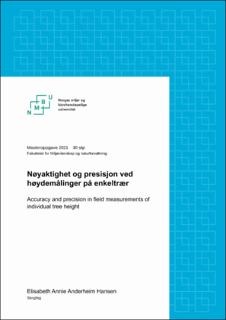| dc.contributor.advisor | Bollandsås, Ole Martin | |
| dc.contributor.advisor | Eid, Tron | |
| dc.contributor.author | Hansen, Elisabeth Annie Anderheim | |
| dc.date.accessioned | 2021-08-03T19:30:22Z | |
| dc.date.available | 2021-08-03T19:30:22Z | |
| dc.date.issued | 2021 | |
| dc.identifier.uri | https://hdl.handle.net/11250/2766061 | |
| dc.description.abstract | For å kunne ta rasjonelle beslutninger knyttet til forvaltning av skog er det viktig at det finnes oppdatert og pålitelig informasjon om skogressursene. Ved hjelp av takseringer kan en hente ut informasjon om skogressursene, og i slike skogtakster er målinger av høyde og diameter i brysthøyde av enkeltrær grunnleggende elementer. Feil i målingene vil direkte påvirke nøyaktighet og presisjon av estimerte tømmervolum eller karbonbeholdninger. Hovedmålet med denne studien var å kvantifisere nøyaktighet og presisjon på høydemålinger på individuelle trær. Datamaterialet til studien ble samlet inn i Ås kommune, Viken fylke, og besto av 71 trær av gran og furu. I tillegg representerte trærne tre forskjellige høyde- og tetthetsklasser. Fasithøydene til trærne ble funnet ved hjelp av en totalstasjon. Høydemålingene ble utført av 13 ulike forsøkspersoner som hadde erfaring med høydemålinger. Forsøkspersonene ble gruppert etter grad av erfaring, med henholdsvis litt og mer erfaring. De statistiske analysene ble gjort i programmet R Studio, og omfattet gjennomsnittlig differanse, gjennomsnittlig standardavvik og RMSE (root mean square error). For å undersøke hvordan målefeil varierer med treslag, tetthet og høyde, ble det gjort variansanalyser og laget en blandet lineær modell. Resultatene viste en systematisk, tilfeldig og total feil for alle målinger på henholdsvis 0.9 %, 6.5 % og 6.6 %. Det var signifikante forskjeller i målefeil mellom enkelte av forsøkspersonene, men når forsøkspersonene ble gruppert etter grad av erfaring kunne det ikke påvises signifikante forskjeller mellom gruppene. Feil varierte mellom grupper av tetthetsklasser, høydeklasser og treslag, men det var kun målinger mellom treslag som var signifikant forskjellig fra null. Lineærmodellen forklarte 6.1 % av de totale variasjonene i målingene, der tetthet, høyde og treslag forklarte kun 1.3 % av variasjonene, mens effekten av ulike personer forklarte 4.1 %. | en_US |
| dc.description.abstract | Making the right decisions in forest management requires updated and reliable information about forest resources. Obtaining information about quantitative and qualitative properties of forests through inventories, is a prerequisite for rational decision making related to management of forests. In such forest inventories, measurements of height and diameter breast height of individual trees are important elements. Errors in the measurements are directly affecting the accuracy and precision of estimated timber volumes or carbon stocks. The main objective of this study was to quantify accuracy and precision of measurements on individual tree height. The data collection consisted of 71 sample trees, of Spruce and Pine, at a study area in Ås, Viken county. The sample trees also represented three different height- and density classes. The actual height for all trees were measured with a theodolite total station. The sample trees were measured independently by 13 observers, which had experience in height measurements. The observers were also grouped after degree of experience. Statistical calculations were done in the programme R Studio, and consisted of mean difference, standard deviation and RMSE (root mean square error). In order to investigate how measurement errors vary between tree species, density and height, the data was analysed with an analysis of variance and mixed linear model. Systematic, random and total error for the whole dataset were 0.9 %, 0.6 % and 6.6 %, respectively. The results from the analysis of variance showed that there was clear significant difference between observers. However, experience could not explain the differences. Measurement errors differed between groups of density, height and tree species, only measurement errors between tree species were significantly different from zero. The linear model explained 6.1 % of the total variation in height measurements errors, and only 1.3 % of this variation was explained by tree species, density and height. The variation due to different observers was 4.1 %. | en_US |
| dc.language.iso | nob | en_US |
| dc.publisher | Norwegian University of Life Sciences, Ås | en_US |
| dc.rights | Attribution-NonCommercial-NoDerivatives 4.0 Internasjonal | * |
| dc.rights.uri | http://creativecommons.org/licenses/by-nc-nd/4.0/deed.no | * |
| dc.title | Nøyaktighet og presisjon ved høydemålinger på enkeltrær | en_US |
| dc.title.alternative | Accuracy and precision in field measurements of individual tree height | en_US |
| dc.type | Master thesis | en_US |
| dc.subject.nsi | VDP::Landbruks- og Fiskerifag: 900::Landbruksfag: 910::Skogbruk: 915 | en_US |
| dc.description.localcode | M-SF | en_US |

